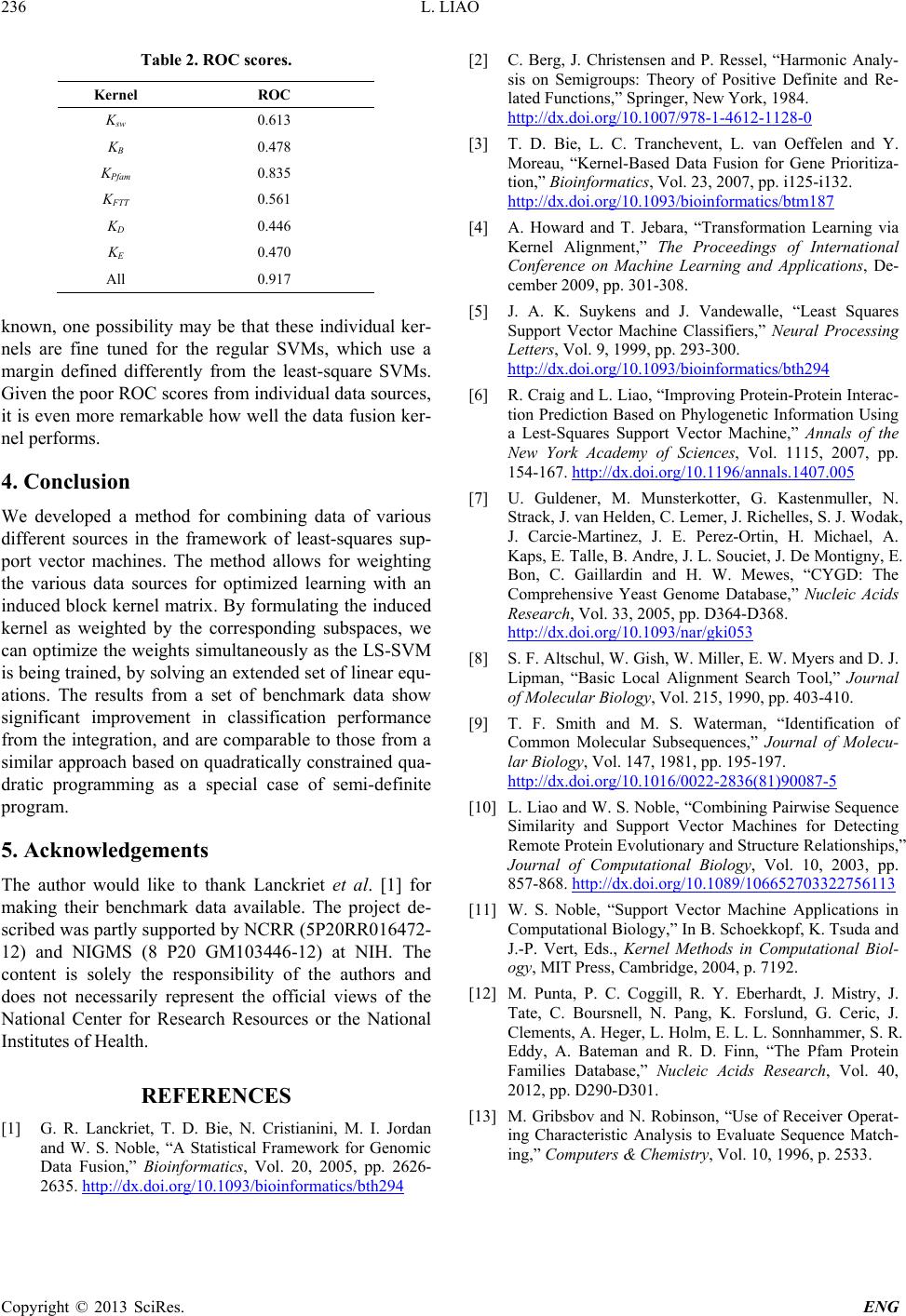
L. LIAO
Copyright © 2013 SciRes. ENG
Table 2. ROC scores.
Kernel ROC
Ksw 0.613
KB 0.478
KPfam 0.835
KFTT 0.561
KD 0.446
KE 0.470
All 0.917
known, one possibility may be that these individual ker-
nels are fine tuned for the regular SVMs, which use a
margin defined differently from the least-square SVMs.
Given the poor ROC scores from individual data sources,
it is even more remarkable how well the data fusion ker-
nel performs.
4. Conclusion
We developed a method for combining data of various
different sources in the framework of least-squares sup-
port vector machines. The method allows for weighting
the various data sources for optimized learning with an
induced block kernel matrix. By formulating the induced
kernel as weighted by the corresponding subspaces, we
can optimize the weights simultaneously as the LS-SVM
is being trained, by solving an extended set of linear equ-
ations. The results from a set of benchmark data show
significant improvement in classification performance
from the integration, and are comparable to those from a
similar appr oach based on quadratica lly constrained qua -
dratic programming as a special case of semi-definite
program.
5. Acknowledgements
The author would like to thank Lanckriet et al. [1] for
making their benchmark data available. The project de-
scribed was partly supported b y NCRR (5P2 0RR0164 72-
12) and NIGMS (8 P20 GM103446-12) at NIH. The
content is solely the responsibility of the authors and
does not necessarily represent the official views of the
National Center for Research Resources or the National
Institutes of Health.
REFERENCES
[1] G. R. Lanckriet, T. D. Bie, N. Cristianini, M. I. Jordan
and W. S. Noble, “A Statistical Framework for Genomic
Data Fusion,” Bioinformatics, Vol. 20, 2005, pp. 2626-
2635. http://dx.doi.org/10.1093/bioinformatics/bth294
[2] C. Berg, J. Christensen and P. Ressel, “Harmonic Analy-
sis on Semigroups: Theory of Positive Definite and Re-
lated Functions,” Springer, New York, 1984.
http://dx.doi.org/10.1007/978-1-4612-1128-0
[3] T. D. Bie, L. C. Tranchevent, L. van Oeffelen and Y.
Moreau, “Kernel-Based Data Fusion for Gene Prioritiza-
tion,” Bioinformatics, Vol. 23, 2007, pp. i125-i132.
http://dx.doi.org/10.1093/bioinformatics/btm187
[4] A. Howard and T. Jebara, “Transformation Learning via
Kernel Alignment,” The Proceedings of International
Conference on Machine Learning and Applications, De-
cember 2009, pp. 301-308.
[5] J. A. K. Suykens and J. Vandewalle, “Least Squares
Support Vector Machine Classifiers,” Neural Processing
Letters, Vol. 9, 1999, pp. 293-300.
http://dx.doi.org/10.1093/bioinformatics/bth294
[6] R. Craig and L. Liao, “Improving Protein-Protein Interac-
tion Prediction Based on Phylogenetic Information Using
a Lest-Squares Support Vector Machine,” Annals of the
New York Academy of Sciences, Vol. 1115, 2007, pp.
154-167. http://dx.doi.org/10.1196/annals.1407.005
[7] U. Guldener, M. Munsterkotter, G. Kastenmuller, N.
Strack, J. van Helden, C. Lemer, J. Richelles, S. J. Wodak,
J. Carcie-Martinez, J. E. Perez-Ortin, H. Michael, A.
Kaps, E. Talle, B. Andre, J. L. Souciet, J. De Montigny, E.
Bon, C. Gaillardin and H. W. Mewes, “CYGD: The
Comprehensive Yeast Genome Database,” Nucleic Acids
Research, Vol. 33, 2005, pp. D364-D368.
http://dx.doi.org/10.1093/nar/gki053
[8] S. F. Altsc hul, W. Gish, W. Miller, E. W. My ers and D. J .
Lipman, “Basic Local Alignment Search Tool,” Journal
of Molecular Biology, Vol. 215, 1990, pp. 403-410.
[9] T. F. Smith and M. S. Waterman, “Identification of
Common Molecular Subsequences,” Journal of Molecu-
lar Biology, Vol. 147, 1981, pp. 195-197.
http://dx.doi.org/10.1016/0022-2836(81)90087-5
[10] L. Liao and W. S. Noble, “Combining Pairwise Sequence
Similarity and Support Vector Machines for Detecting
Remote Protein Evolutionary and Structure Relationships,”
Journal of Computational Biology, Vol. 10, 2003, pp.
857-868. http://dx.doi.org/10.1089/106652703322756113
[11] W. S. Noble, “Support Vector Machine Applications in
Computational Biology,” In B. Schoekkopf, K. Tsuda and
J.-P. Vert, Eds., Kernel Methods in Computational Biol-
ogy, MIT Press, Cambridge, 2004, p. 7192.
[12] M. Punta, P. C. Coggill, R. Y. Eberhardt, J. Mistry, J.
Tate, C. Boursnell, N. Pang, K. Forslund, G. Ceric, J.
Clements, A. Heger, L. Hol m, E . L. L. Sonnhammer, S. R.
Eddy, A. Bateman and R. D. Finn, “The Pfam Protein
Families Database,” Nucleic Acids Research, Vol. 40,
2012, pp. D290-D301.
[13] M. Gribsbov and N. Robinson, “Use of Receiver Operat-
ing Characteristic Analysis to Evaluate Sequence Match-
ing,” Computers & Chemistry, Vol. 10, 1996, p. 2533.